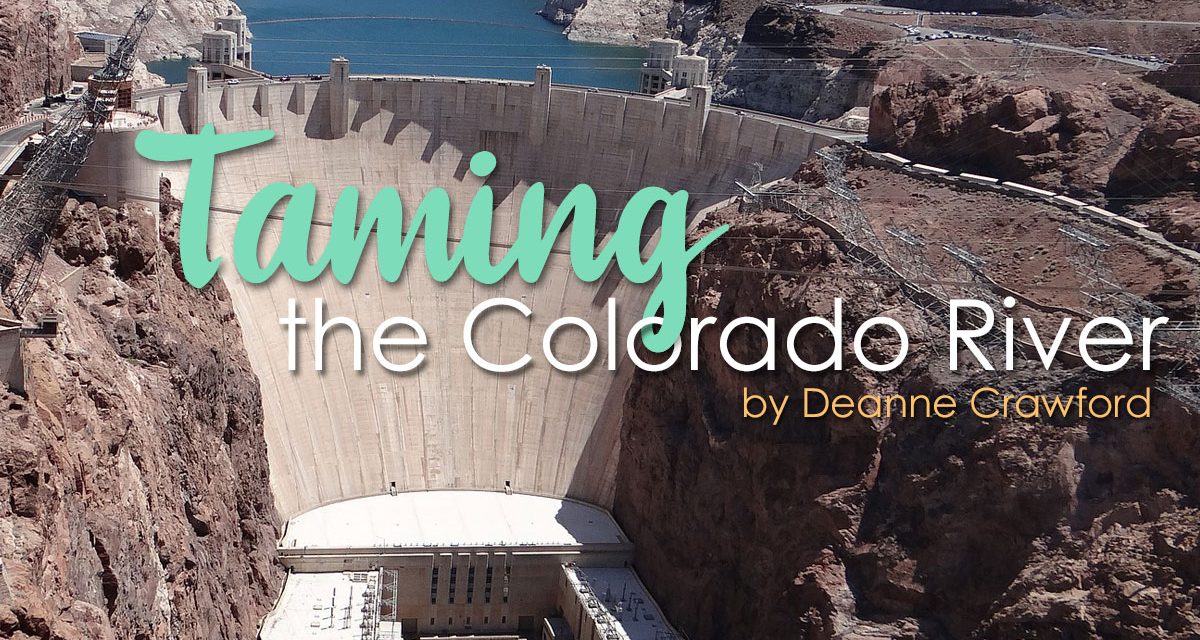Officially opening on March 1, 1936, the Hoover Dam is a marvel of engineering and architecture. From the beginning, engineers, and designers sought to improve American lives in the Southwest, but it came at a cost. Whether the story of Hoover Dam is familiar or unknown, rally your children and let’s explore the good, the bad, and the beautiful of this stunning structure.
On a map, find the Colorado River. As a major river in the American southwest, it flows 1450 miles from the Rocky Mountains through Colorado, Utah, Arizona, Nevada, California, and into the Sonora Desert. It is fed by major tributaries in Wyoming and New Mexico. How many can you identify on a map? Before 1998, the Colorado River extended into the Sea of Cortez (Gulf of California). It is theorized that controlling water flow, irrigation, and climate change have all played a role in this change. Ask children to explain how each of these may have impacted the river. If this is new info, spend time learning about dams (K-5) or have older students (5th-8th grade) explore National Geographic Dams. But let’s back up!
From the time of the Colorado Gold Rush through the end of the American Civil War, the number of people settling in the Old West exploded. Whether in search of prosperity or freedom, the undeveloped land along the Colorado River became home to many. Survival was difficult in many areas of the Southwest, in part due to the desert climate. One area that presented the greatest hardship was the Imperial Valley. The Colorado River was diverted into canals for irrigation based on the belief that the area would become a lavish, green landscape. In 1900, the California Development Company was granted permission to build canals. The first canal, spanning 14 miles, began in Pilot Knob, and crossed into Mexico to the Alamo River. While most of the canal ran through Mexico, it laid the foundation for a viable water supply to the desolate land. Canals were expanded and fortified until tragedy struck in 1905! Extensive rains and flooding destroyed most of the project and filled the Salton Basin, creating the Salton Sea. That is Interesting explores its troubled past and future.
What does this unsuccessful canal have to do with the Hoover Dam?
In 1902, President Theodore Roosevelt signed the Reclamation Act to provide funding to “reclaim” the barren land of the American West through water redistribution. While a great number of dams were constructed, the Hoover Dam was to be the largest in the world at the time. While no longer the largest dam in the world, it is still an amazing site to see! Locate Hoover Dam on a map (or Google Maps).What state(s) is it located in? What is the largest city near the dam? If you have visited the dam, take a moment, and share how it felt to see it. What impressed you the most? If you have never seen it in person (or even if you have), take a few minutes to tour Hoover Dam online.
Fun rabbit trail! Did you know that the name has not always been Hoover Dam? Unofficially, the dam was known as Boulder or Black Canyon Project when construction began. Then Black Canyon was discovered to be a more suitable spot for the dam. In 1930, Secretary of the Interior Ray Lyman Wilbur ordered that the dam be built in Colorado’s Black Canyon and be called Hoover Dam. A Congressional Act in 1931 made this official. But not everyone agreed, especially as the Great Depression continued hurting our nation. People didn’t like President Hoover, and many blamed him for the ongoing troubles. After he lost the election in 1932 to Franklin D. Roosevelt, people commonly named it Boulder Dam. It wasn’t until 1947 that President Harry S. Truman signed a resolution that restored the name to Hoover Dam.
From the signing of the Reclamation Act until construction started in 1931, engineers, developers and government officials studied, analyzed, and debated the best way to reach the goal of diverting the Colorado River to meet needs of the developing West. It was determined that more could be done than ‘just’ providing water. Could you use the stored water as a power source? What if the water was harnessed to supply electricity to help repay some of the money needed to build the dam? Why do you think it is was important for the government to find a way to fund the dam construction? Although the bill was signed nearly 30 years prior, and the money should have been reserved for the work, America was in the middle of the Great Depression in 1931! Construction was planned to begin in the Fall of 1931, allowing 7 years to complete. Looking for a way to bring jobs to America, President Hoover pushed to start construction early, and rallied for around-the-clock work. Under his influence, Hoover Dam was completed ahead of schedule and the mighty Colorado River was finally tamed by man! But this success did not come easily.
Watch Building the Hoover Dam (older children) and TED-Ed’s “Blood, Concrete, Dynamite-the Building of Hoover Dam.” (Parents, TED-Ed talks about the challenges gently, but some young children may find it troubling. Use your discretion, as you know your children best). Many people were out of work, so laborers and their families came from across the U.S. to be hired for the dam project. Living conditions were rough at the beginning; most lived in makeshift tents. Remember, the land was still dry, hot, and barren. In order to accommodate the workers and their families, the government created a camp with large dormitories for single men and small cottages for families. A mess hall was built that served 3 meals per day for a small charge. A church and library were also built. Interestingly, the camp had an overseer who established numerous rules to follow. He also established a security gate to protect the community. The developing camp became known as Boulder City. While the government provided stability for families, it also had flaws. It did not fund formal schools or medical care for the residents. Pulling their funds, Six Companies (who oversaw the dam construction) made temporary schools and built a hospital. But the hospital treated the workers only, and not their families. Do you see any problems this may have caused? But this was not the only problem. Another issue was discrimination. Hired workers were mostly white. Although African Americans, Hispanics, and Native Americans were hired eventually, they were not allowed inside the Boulder City gates.
Building Hoover Dam was a massive project. The dam had to be big to hold back large amounts of water. This created a reservoir called Lake Mead, the largest man-made lake in the United States. Shaped like an axe-head, Hoover Dam is 45 feet across the top and has a 660 ft. thick base at the bottom. It stands over 700 ft. tall. Have you ever visited any monuments or skyscrapers? Take a moment to look up the size of those compared to Hoover Dam? The dam required 4.5 million cubic yards of concrete to build. Laying the concrete in a straight line, you could build a road from San Francisco, CA. to New York City. (Driving this far it would take you nearly 2 days straight!) Can you imagine the manpower it took to build this? But more than an amazing architectural monument, the dam was built to create electricity. Watch David Macaulay’s Building Big video clip. Hydroelectricity (using water to produce electricity) is a renewable resource. This simply means that we will never run out. Learn about the journey of hydropower here. It is estimated that the 17 turbines (or generators) at Hoover Dam produce electricity to more than 1.3 million homes across Arizona, Nevada, and California! Research how many people live in your city. If you estimate there are 4 people living in each house, would there be enough electricity produced by the dam to meet the needs of your community? If you live in a small town, expand your search. How many towns in your area could be served by the power generated by Hoover Dam? Want to dig more into the Sciences of Hoover Dam or hydroelectricity? Check out Hoover Dam’s Learning Packet or NASA’s Eco-Kids Fresh Water.
If you watched the TED-Ed talk, you learned how dangerous it was to work on the dam project. Although new safety measures like tar covered “hard” hats were introduced, other dangers were rampant. Ask your children what types of dangers the builders may have faced? (Heat stroke, falls, drownings are examples). Officially, the project had 96 construction-related fatalities. The most dangerous job at the construction site was the building of diversion tunnels, which happened in the first phase of construction. Diversion Tunnels were necessary to channel the water from the river so the men could lay the base of the dam. The riverbed needed to be dry before the dam’s foundation could be built. These tunnels are now used as spillways if too much water accumulates in the reservoir behind the dam. Once the tunnels were built, men cleared loose rock and debris from the canyon walls, a necessary task to make sure the dam would be secured into walls. Men working along the steep canyon were secured with safety harnesses, although missteps and fallen rock were problematic. There were some pretty amazing rescues during this phase, but also many tragedies.
“The building of Hoover Dam belongs to the sagas of the daring,” summarizes the vision for the Hoover Dam Memorial created by Oskar J.W. Hansen. Dedicated in 1935, the Winged Figures of the Republic serve as guards to the Hoover Dam entrance. Representing strength, the muscular bronze figures sit on top of a polished black diorite base. These winged figures guard an American flag proudly displayed on a 142-foot flagpole. Oskar J.W. Hansen goes on to describe the figures, “The winged bronzes which guard the flag, therefore, wear the look of eagles. To them also was given the vital upward thrust of an aspirational gesture; to symbolize the readiness for defense of our institutions and keeping of our spiritual eagles ever ready to be on the wing.” Study the monument here. What do you notice about the winged figure? Does Mr. Hansen’s description fit the figure? Why or why not? Take time to sketch the winged figure. Below the figures, the ground is inlaid with a star chart aligned to the exact placement of Nevada skies on September 30, 1935, the day the dam was dedicated. He also created a plaque to commemorate the men who died during the dam’s construction. His inspiring tribute serves as a reminder of the sacrifices made to improve the life in the Southwest: “They died to make the dessert bloom. The United States of America will continue to remember that many who toiled here found their final rest while engaged in the building of this dam. The United Sates of America will continue to remember the services of all who labored to clothe with substance the plans of those who first visioned the building of this dam.” Do you think his dedication honored the families of the lost workers? Consider the words of Oskar J.W. Hansen as he contemplated his visionary design. “Man has always sought to express and preserve the magnitude of his exploits in symbols…They form the connecting link between the spiritual and material world. They are the shadows cast by the realities of the soul.” Do you feel his winged figures connect the spiritual and material world? Why or why not? What kind of monument would you have designed? Consider the lives lost during this significant accomplishment for humanity. Design a memorial to remember the workers lost and write a dedication to their sacrifice. Share it with your family.
The Hoover Dam’s magnificence is blemished by the great sacrifices made. However, as Americans, we can be grateful for these sacrifices by learning their stories and seeking to preserve this history for generations to come. It is my hope your family enjoyed this study and learned a bit more of America’s story. ~ Deanne





